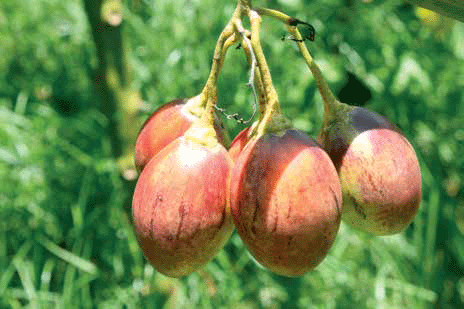
Grafting Tree-Tomatoes with indigenous trees
The original plant has shallow roots and is easily knocked down by strong winds and thus farmers have for long resorted to grafting it with indigenous trees that have deep tap roots making it more stable, easier to find water and fight against soil nematodes.
This is what James Njeru Ndirangu has been doing for the last 10 years in Kangaita, Tetu Subcounty, Nyeri. He grafts his tree tomato with the indigenous muthakwa tree. The tree grows wild and is actually a very large tree compared to the 3-5 metres that tree tomatoes grow to. In the wild, muthakwa can grow to 2-3 floors high.
He used to drive grader tractor for tarmacking roads, he decided to quit and move to farming. The transition from urban to rural areas for him was hard. It is then he saw a friend who had planted 10 tree tomatoes.
He thought if he had 500 trees, that would help him because of the economies of scale. He currently has 800 trees. An acre takes 1200 tree tomato plants.
The various tree tomato varieties are distinguished by their particular color. There is the red fruits variety, yellow fruits variety and dark-red or black variety. The red variety which James has planted is mostly sold localy in fresh produce markets. He sells his at Karatina, City Market and Ngara fruits Market. He sells a kilo at Kshs. 120.
The yellow tree tomato variety is good for preserving because of its superior flavour. The dark red or black variety is the biggest of all tree tomatoes and also of the highest quality among the three.
Tree tomato fruits are normally consumed fresh. You eat it by cutting it into two halves and scooping out the flesh. The tree tomato flesh can be used to give stews a unique flavor. It is also used in salads and desserts. It is also blended with water and sweetened with sugar to make juice. Before blending, remove the skin by pouring boiling water over the fruits and leave it for 5 minutes. This softens the skin for peeling.
Tree tomatoes were first planted in Kenya by Asians in the 1800’s. Propagation is done through seeds or cuttings. The tree tomato is partial to subtropical climate where rainfall is between 600-4000 millimeters and temperatures range from 15-20°C and at an altitude of between 1,500m to 3,000M above sea level.
Generally, anywhere citrus fruits grow well, tree tomatoes can do well too. Tree tomatoes require soils with a pH of 5 to 8.5. Tree tomatoes in Kenya are grown in Nyeri, Kericho, Murang’a, Migori, Kakamega, Meru, Embu, Nyandarua and Kisii.
Tree tomato seeds should be treated against soil-borne pests, soil-borne fungal infections and seed dormancy before planting. They are planted at 4ft between plants and 5ft between rows. They require plenty of nitrogen and trace elements.
Tree tomatoes start producing fruit from 1.5 to 2 years and produce 1 to 6 fruits per cluster. James gets half a kilo tree-tomato from each tree every 2 weeks. He harvests all year round.
It is advisable to support the branches as the weight of the fruits combined with wind might break them. Plant trees as wind breakers along the edges of the farm.

